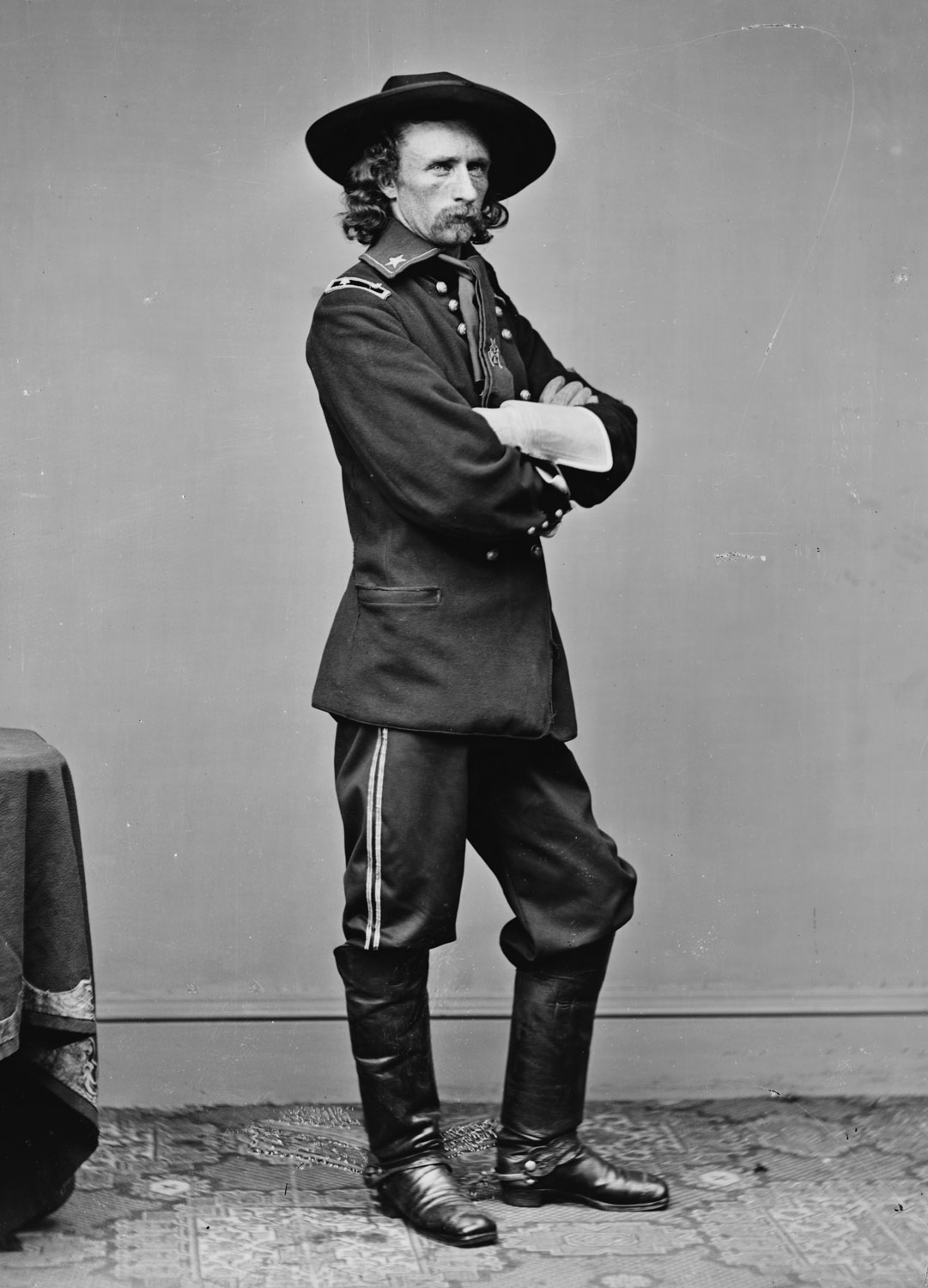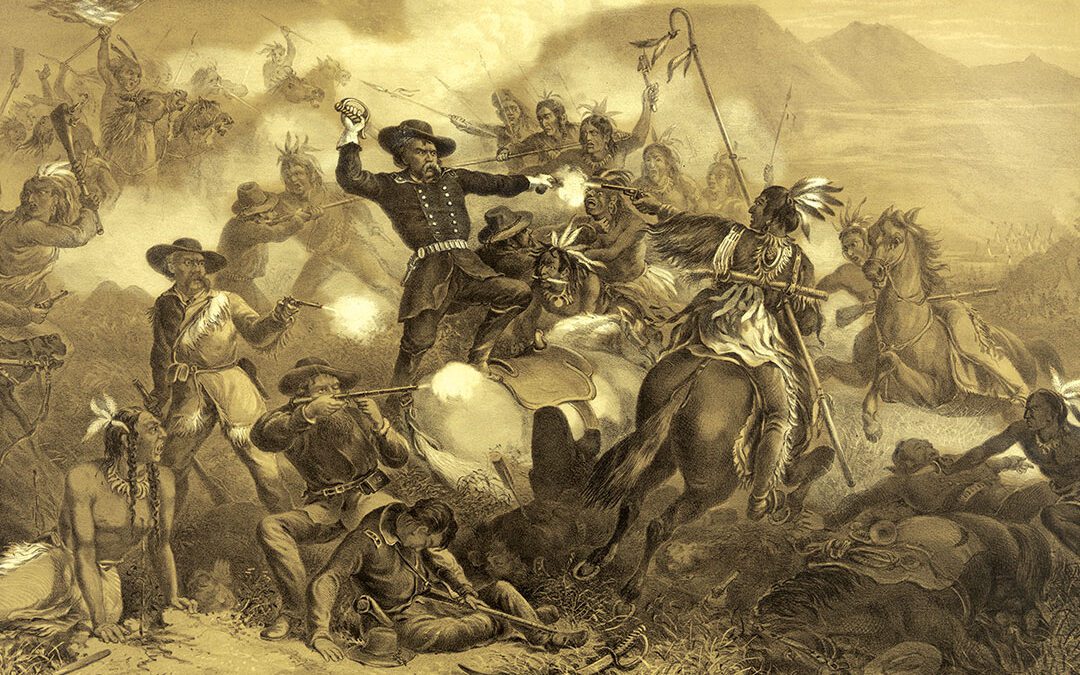Trout fishing was an important part of the European settlement of the American West from the very beginning. Explorers, trappers, pioneers, soldiers and homesteaders – all brought along fishing tackle as they pushed westward across the Great Plains and into the Rocky Mountains where they found rivers and streams flowing with clear, cold water and fairly bursting with new and exotic members of the family salmonidae. Yet in a truly bizarre and little-known episode of western history, trout fishing played an improbable role in the outcome of the most infamous Indian battle of the 19th century frontier.
The discovery and description of cutthroat trout by Meriwether Lewis at the Great Falls of the Missouri River in 1805 is justly celebrated in the natural history of the West. But perhaps no episode in the long and colorful history of western trout fishing is more unlikely than the one that occurred in Montana seven decades later, not very far from the very place where Lewis pulled his first cutthroat from the pristine waters of the Missouri.
On Sept. 13, 1877, Capt. Frederick Benteen commanded a company of the 7th Cavalry at the Battle of Canyon Creek… armed with a fly rod! An inveterate fisherman, Benteen led a wild cavalry charge against the Nez Perces Indian encampment near the Yellowstone River, wildly waving the rod and urging his men forward as bullets whizzed around his head. To the man Benteen’s troopers agreed their leader had demonstrated considerable coolness and courage under fire.
A few weeks later at the surrender of the Nez Perces following the Battle of Bear’s Paw, Chief Joseph, the legendary leader of the Nez Perces on their heroic but ill-fated flight to Canada, asked to meet the man his warriors had tried so hard to kill at Canyon Creek. The Nez Perces warriors clearly were impressed by their opponent’s bravery, if not his eccentricity.
Chief Joseph identified this courageous soldier as an officer wearing a buckskin jacket, chewing on a pipe and madly waving a fishing rod. The two men were duly introduced and had an amiable chat. No record of the conversation is known to exist, and Benteen did not mention it in any of his many letters to his wife, but one cannot help but speculate that perhaps the erstwhile enemies swapped stories about their respective fishing exploits. It’s probably unlikely given the circumstances, but it’s pleasant to think that maybe they traded tall tales, as fishermen almost universally are inclined to do.
A native Virginian who remained loyal to the Union, Benteen fought with notable courage during the Civil War and in the wars with the Plains Indians. He was a popular commander among his troops who appreciated his unpretentious informality and obvious concern for their well-being.
One of Benteen’s troopers recalled fondly, “I saw him wade over his boot tops many times into cold water to get mountain trout.”
By all reports Benteen took full advantage of his military service in the West to explore the virgin streams of the Rocky Mountains and to pursue trout whenever his duties permitted.
Despite his dashing charge at Canyon Creek and well-deserved reputation for courage, Benteen had made more than his share of enemies in the Army because of his loathing for, and very vocal criticism of, his commanding officer, George Armstrong Custer. Benteen regarded Custer as a braggart, a blowhard and a vainglorious incompetent. Worse, Benteen made little effort to conceal his opinion. In fact, he once boasted that he was proud to say he thoroughly despised the flamboyant Custer.
Critically assessing his commander’s actions at the controversial Battle of the Washita in 1868 – an eerie precursor of the Little Bighorn disaster – Benteen believed Custer was reckless with the lives of his troopers in pursuit of personal glory. One notable confrontation between the two men almost resulted in gunplay.
In June 1876, a year before his fly rod-waving heroics at Canyon Creek, Benteen was with Custer on the trail of Sitting Bull. As is now well known, at the Little Bighorn Custer twice divided his forces before an enemy of unknown strength, a major military blunder. Before making any effort to determine the number of the Indians in the huge encampment on his front, Custer dispatched Benteen and three companies of troopers on what turned out to be a wild goose chase. Some historians suspect Custer did not want Benteen, his bitter enemy, to share in the glory of defeating Sitting Bull and Crazy Horse. Everyone knows the inevitable result of Custer’s dubious decisions.
Returning from his long and pointless excursion around the right flank of the Lakota-Cheyenne encampment, Benteen arrived back near the scene of the celebrated Last Stand just in time to witness the disaster unfolding. He coolly rallied the panic-stricken and retreating company of Major Marcus Reno – who had lost both his composure and control of his men. Although Reno outranked him, Benteen effectively took command and restored order. He mounted an effective fighting retreat and perimeter defense against the Indian onslaught.
Having finished off Custer, the combined Indian force fought for a day and a half in an effort to wipe out the battered remnants of the 7th Cavalry. Benteen’s coolheaded leadership is generally credited with having saved the balance of Custer’s command from annihilation.
After the ignominious debacle at Little Bighorn, Custer’s widow mounted a public relations campaign to exonerate her martyred husband of responsibility and transform him into a tragic hero – and equally to blame Benteen for not leading his troops into the maelstrom at Last Stand Hill to rescue the reckless boy general. Had Benteen done so, almost without doubt both he and his men would have shared in Custer’s most unpleasant defeat.
Incredibly, Custer’s fate actually may have been sealed as much by the allure of Montana’s trout fishing as by his own foolhardy, glory-seeking bungling.
Ken Owens, in his excellent article “While Custer Was Making His Last Stand,” writes: “. . . at the same time Custer was blundering into Sitting Bull’s camp and getting himself and his men massacred, a column of reinforcements under General George Crook that might have saved the day was comfortably camped close by on Goose Creek near the Tongue River – fishing! It seems that Capt. Benteen was not the only soldier to be awestruck by the remarkable trout fishing available in Montana that fateful summer of 1876.”
Crook’s column was one of three that commanding General Alfred Terry had dispatched to search out and converge on the Indian confederation: one under Terry himself and including Custer, and two others under General Crook and Colonel John Gibbon.
On June 17, 1876, a week before the nation-rattling events at the Little Bighorn, the column commanded by Gen. Crook stumbled into the Battle of the Rosebud near the Yellowstone River. After being manhandled by Crazy Horse, Crook withdrew to an encampment on Goose Creek, where his troopers previously had enjoyed some spectacular trout fishing while on their march to join up with Custer.

As Custer rushed headlong toward his destiny at the Little Bighorn, General Crook and his beleaguered men were only too happy to take a break from the messy, dangerous and unpredictable business of Indian fighting. Crook’s command settled down on Goose Creek for more than a week of R&R. And what better way to rest and relax than indulge in a little fishing? And the company, it seems, produced some truly prodigious catches. Using a combination of artificial flies and natural bait – live grasshoppers impaled on a bare hook proved especially effective – the greedy troopers caught huge numbers of eager Yellowstone cutthroats. They might not have been able to defeat the Sioux on the Rosebud, but by God they could put a whipping on the trout in Goose Creek!
Three days after Custer’s Last Stand, for example, Crook’s men bagged no fewer than 500 trout! According to Captain John Bourke, who wrote a book on his western adventures with Crook, the general was every bit as caught up in the fishing frenzy as was his troopers. Indeed, Crook is reputed to have brought along his very own personal fly-tier to keep himself well supplied!
Most of the anglers took 15 to 30 trout daily. Captain Bourke recorded that one fellow officer, aided by two troopers, bagged 146 cutthroats in a single day. Bourke’s On the Border with Crook, published in 1891, provides a firsthand account of the general’s controversial fishing expedition during the Sioux-Cheyenne campaign of 1876.
Although Crook’s column was under orders to advance and unite with Custer and Gibbon near the Little Bighorn to corner the elusive Indians – and thereby reinforcing the 7th Cavalry before it engaged the Lakota-Cheyenne warriors – instead the general and his command inexplicably spent a leisurely week not in pursuit of Sitting Bull, but chasing trout. All thoughts of pursuing “wild” Indians were put aside as Crook and his men idled away the days on the banks of Goose Creek.
Historians ever since have speculated as to how events might have turned out that summer had the cutthroats been a little less eager and Crook not dallied for a week of fishing while Custer hurried to his doom. On the other hand, had Custer been a little more interested in exploring the angling opportunities frontier Montana afforded, and a little less bent on seeking personal glory, he might not have blundered into his dubious place in history.
As with all “what if” history, we will never know if Crook could have reached Custer in time to prevent the disaster at the Little Bighorn. Most fly fishermen, however, will understand and perhaps forgive General Crook’s reluctance to saddle up and take premature leave of such extraordinary fishing. Few fly fishers would willingly abandon a stream when trout are “on the bite” as they were that fateful June week in 1876.
And what was the fate of Custer’s nemesis, the heroic but impolitic fly fisherman Captain Frederick Benteen? Well, his enemies finally caught up with him. He was charged with drunkenness on duty and convicted by a court marshal. Reduced in rank and pay, Benteen maintained his innocence – both of the alleged drunkenness and his “failure” to ride to Custer’s rescue – until his death in 1898. He is buried in Arlington National Cemetery. Frederick Benteen remains, so far as is known, the only American soldier ever to go into combat armed with a fly rod.

